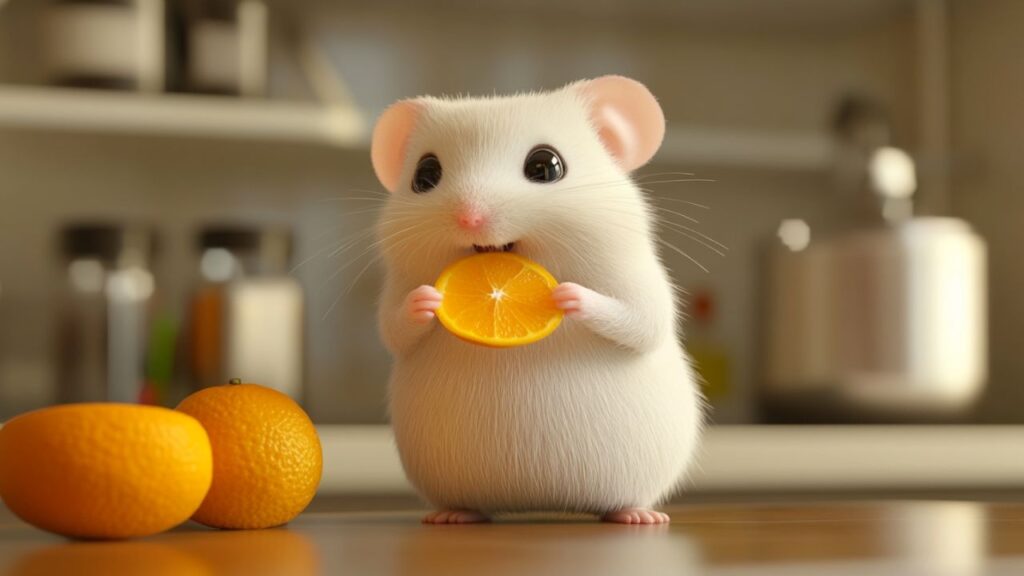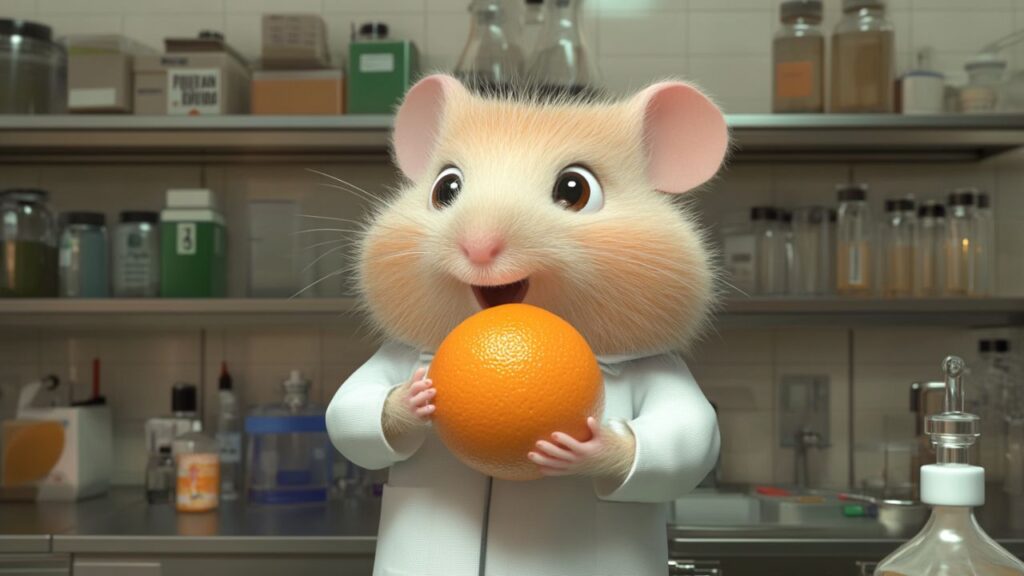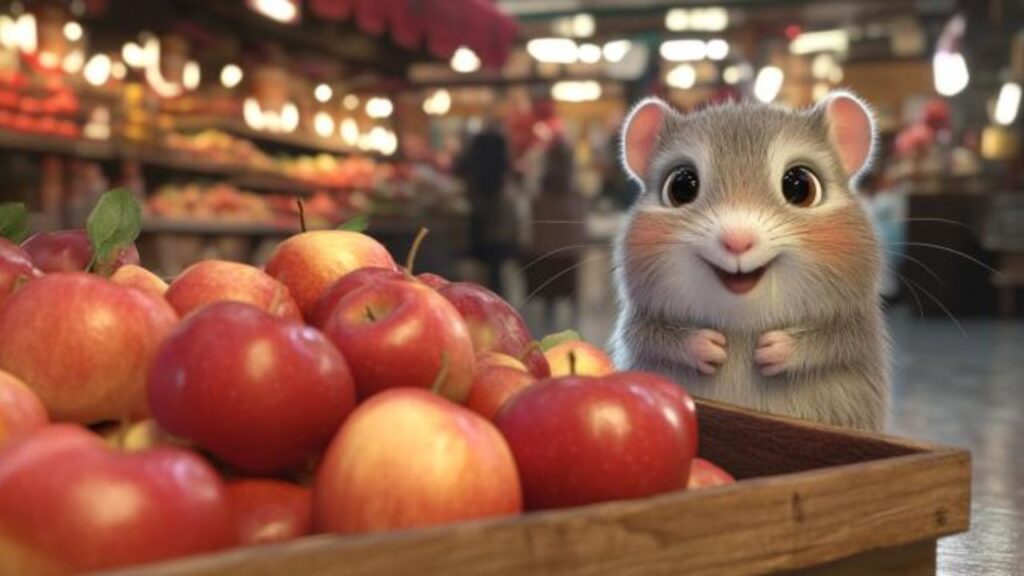As a hamster owner, you’ve likely wondered if you can share some of your favorite snacks with your furry friend. Fruits, with their natural sweetness and juicy texture, often seem like a great treat. But when it comes to hamsters, not all fruits—or parts of fruits—are created equal. One common question that arises is: can hamsters eat orange peels?
Hamsters have delicate digestive systems, and while they love to nibble on a variety of foods, certain treats can pose health risks. It’s crucial to be informed about what’s safe and what could potentially harm your pet, especially when it comes to fruits that are naturally acidic, like oranges. A little nibble of the wrong thing could lead to tummy troubles or worse.
In this guide, we’ll explore the specifics of whether orange peels are safe for hamsters to eat. While the juicy flesh of many fruits is often a delightful treat for hamsters, the peel is another story. Just because something is edible for humans doesn’t mean it’s safe for our tiny companions. Let’s take a closer look at why this is the case, and what the risks and benefits of orange peels might be for your little friend.
The Importance of Knowing What Foods Are Safe for Hamsters
Hamsters may be small, but their nutritional needs are complex. As omnivores, they enjoy a wide range of foods, from fresh veggies to seeds, but there are some critical differences between what we can eat and what they should eat. The wrong snack could lead to digestive issues, allergic reactions, or even toxicity in extreme cases. That’s why being well-informed about your hamster’s diet is so important.
Some fruits, like apples and carrots, are often celebrated as hamster-friendly treats in small amounts. However, citrus fruits like oranges present a unique challenge. The acidity in citrus can cause irritation in a hamster’s digestive system, and certain parts, such as the peel, may contain chemicals or pesticides that are harmful to such a tiny body. While fruits are nutritious, it’s crucial to differentiate between what’s safe for humans and what’s truly safe for hamsters.
Why Not All Parts of Fruits Are Safe for Hamsters
It’s tempting to think of fruit as a wholesome treat in any form, but when it comes to hamsters, we need to be a bit more cautious. Even when a fruit itself is safe, like the inner flesh of an apple or a slice of banana, the skins, peels, or seeds often come with hidden dangers. Peels, especially, are tougher for hamsters to digest and can sometimes contain higher concentrations of pesticides or other chemicals used in the growing process.
For citrus fruits like oranges, the peel is particularly tricky. While the peel contains some nutritional value for humans, such as fiber and essential oils, the same benefits do not extend to hamsters. In fact, those essential oils can be too strong for your hamster’s sensitive system, leading to gastrointestinal discomfort or worse. Plus, the acidity of orange peels can cause irritation or imbalance in your hamster’s digestive tract, leading to unpleasant health issues.
Are Orange Peels Safe for Hamsters?

Quick Answer: No, Orange Peels Are Not Safe for Hamsters
The quick and simple answer to whether hamsters can eat orange peels is no. Orange peels are not considered safe for hamsters due to their acidity and other factors that can cause digestive issues. While hamsters can enjoy some fruits in moderation, citrus fruits, particularly their peels, should be avoided.
While oranges may seem like a harmless fruit treat for humans, their peels contain components that make them unsuitable for your tiny hamster. The tough, fibrous texture, combined with the presence of natural oils and acids, creates a potentially harmful snack for your little friend.
The Problem with Acidity: How Oranges Impact Hamster Health
One of the primary reasons orange peels are dangerous for hamsters is the high acidity found in citrus fruits. Oranges, lemons, limes, and grapefruits all belong to the citrus family, which is notorious for its strong acidic properties. This acidity doesn’t sit well with hamsters’ sensitive digestive systems.
When a hamster consumes acidic foods like orange peels, it can lead to several health issues, including:
- Stomach irritation: The acidic content of the orange peel can irritate the lining of your hamster’s stomach, causing discomfort, nausea, and even diarrhea. Hamsters have small and delicate digestive tracts, so any irritation can quickly lead to serious digestive problems.
- Imbalance in gut flora: A hamster’s gut is filled with beneficial bacteria that help break down food. The high acidity of citrus can disrupt this balance, leading to digestive upsets or even a weakened immune system. When the natural gut flora is disturbed, it can also make your hamster more susceptible to infections or digestive blockages.
- Potential toxicity from essential oils: Orange peels contain essential oils like limonene, which are harmless to humans but can be toxic to small animals like hamsters. These oils are concentrated in the peel and can cause digestive distress or toxicity if ingested by your pet.
Can Hamsters Handle Any Amount of Acidity?
Unlike humans, who can tolerate a range of acidic foods, hamsters are not designed to handle high levels of acidity. Their natural diet consists mainly of grains, seeds, and the occasional fruit or vegetable. These foods are typically low in acidity and easy to digest.
Even small amounts of citrus fruits can lead to oral irritation in hamsters, causing discomfort in their mouths and potentially leading to decreased appetite. In severe cases, prolonged exposure to acidic foods can even damage a hamster’s teeth, as the acids wear down the enamel.
Given the combination of acidity and the oils found in orange peels, it’s clear that this part of the fruit poses more risks than benefits to your hamster’s health. Therefore, it’s best to keep orange peels (and all citrus products) out of your hamster’s diet entirely.
Nutritional Content of Orange Peels: The Good, the Bad, and the Bitter

Orange peels may seem like a surprising candidate for nutrition, but they’re packed with vitamins, fiber, and other beneficial compounds that make them valuable in human diets. However, when it comes to hamsters, what’s nutritious for humans doesn’t always translate into a safe or beneficial snack for our small pets. Let’s break down the nutritional components of orange peels, examining the good, the bad, and the bitter—specifically through the lens of hamster health.
The Good: Vitamins and Fiber in Orange Peels
From a nutritional standpoint, orange peels are loaded with vitamins and fiber that are generally considered beneficial to humans. However, these same nutrients aren’t as advantageous for hamsters, particularly when considering the way they’re packaged in the tough, fibrous peel.
- Vitamin C: Orange peels are rich in vitamin C, which plays a critical role in boosting immune function and aiding tissue repair in many animals. However, unlike humans, hamsters can synthesize their own vitamin C, so they don’t require it from external sources. While a little extra vitamin C won’t necessarily hurt, the risks associated with orange peels far outweigh any potential benefits of this vitamin.
- Fiber: Orange peels contain a significant amount of fiber, which helps with digestion in humans. In small pets like hamsters, however, the coarse fiber found in the peel may be too tough to digest properly, especially when consumed in large quantities. Instead of aiding digestion, the high fiber content can result in digestive blockages or discomfort for your hamster.
While these nutrients might seem beneficial, it’s important to remember that a hamster’s digestive system is not built to process the thick, fibrous material of orange peels. Hamsters thrive on softer, more easily digestible plant matter and grains.
The Bad: Essential Oils and Pesticide Residues
Beyond the basic nutrients, orange peels contain natural compounds that are more problematic for hamsters. Two key concerns are the presence of essential oils and potential pesticide residues.
- Essential Oils (Limonene): Orange peels contain essential oils, the most notable being limonene, which gives the fruit its characteristic citrus scent. While limonene may offer health benefits for humans—such as acting as an antioxidant or anti-inflammatory agent—it can be harmful to hamsters. Hamsters’ bodies are much more sensitive to concentrated oils, and limonene has been shown to cause irritation in small mammals, particularly in their digestive tracts. Even in tiny amounts, these oils can upset a hamster’s delicate system.Essential oils can also trigger toxicity in hamsters if ingested in large amounts. Unlike the fleshy part of the fruit, where the oils are less concentrated, the peel is where these compounds are heavily concentrated, posing a risk to your pet.
- Pesticides: Unless you’re using organically grown oranges, the peel is often coated in pesticides, herbicides, and other chemicals used during the farming process. Even if you thoroughly wash the fruit, some chemical residues can linger on the peel. These residues are harmful to hamsters, who are more susceptible to toxins due to their small size and sensitive systems. Pesticide ingestion can lead to poisoning, organ damage, or other severe health complications in hamsters.
The Bitter: Tannins and Acidity
The bitterness of orange peels comes from compounds like tannins, which are another source of concern for hamster health. While tannins are found in a variety of foods and are often associated with antioxidant properties, they can be problematic in excess, particularly for small animals like hamsters.
- Tannins: These bitter compounds can cause digestive upset in hamsters, leading to reduced appetite or gastrointestinal distress. Though tannins are naturally occurring and not inherently toxic, their astringent nature can irritate your hamster’s stomach and intestines, making the peel an unpleasant and potentially harmful snack.
- Acidity: While the flesh of an orange is acidic, the peel also contains a significant amount of citric acid, which is even more concentrated than in the fruit itself. As mentioned earlier, hamsters’ stomachs are not equipped to handle acidic foods. Even a small amount of the acidity from the peel can lead to discomfort, oral irritation, and potential digestive problems for your hamster.
Potential Risks of Feeding Orange Peels to Hamsters

Acidity, Digestive Issues, and Chemicals
One of the primary concerns with feeding orange peels to hamsters is their high acidity. Oranges, like all citrus fruits, contain citric acid, which is responsible for their tangy taste. This acidity can wreak havoc on a hamster’s sensitive digestive system. Hamsters are not built to process acidic foods, and consuming orange peels can lead to:
- Stomach irritation: The acids in orange peels can cause irritation in your hamster’s stomach lining, potentially leading to discomfort, diarrhea, or nausea.
- Digestive disturbances: Due to their tiny digestive tracts, hamsters are prone to gastrointestinal issues when fed inappropriate foods. The tough, fibrous nature of orange peels, combined with their acidity, can lead to blockages or severe upset in the digestive system.
Moreover, commercially grown oranges are often treated with pesticides and chemicals. While thorough washing can remove some surface residues, it’s nearly impossible to remove all traces from the peel. These chemicals are especially dangerous for hamsters, given their small size and sensitivity to toxins. Even trace amounts of pesticides can cause health issues like vomiting, lethargy, or even long-term organ damage.
Allergic Reactions or Sensitivities in Hamsters
Just like humans, hamsters can have allergic reactions to certain foods. While citrus allergies in hamsters aren’t commonly documented, it’s still possible for a hamster to show signs of an allergic reaction to orange peels. Reactions can range from mild to severe, including symptoms like:
- Swelling around the mouth or face
- Excessive scratching or discomfort after eating the peel
- Respiratory issues such as sneezing or wheezing
- Digestive upset, including diarrhea or vomiting
Given these potential risks, it’s clear that orange peels offer far more harm than benefit to your hamster.
Are Any Parts of Oranges Safe for Hamsters?

Safety of Orange Flesh Versus Peel
While the peel is undoubtedly dangerous for hamsters, what about the flesh of the orange? The inner, juicy part of the fruit is less acidic than the peel and contains some beneficial nutrients like vitamin C and antioxidants. However, this does not mean it’s entirely safe for your hamster.
The flesh of an orange still contains enough acidity to upset a hamster’s digestive system. Even in small quantities, the acidic content can cause oral irritation and stomach discomfort. For this reason, citrus fruits, including oranges, are best avoided entirely in your hamster’s diet. If you’re ever tempted to offer a tiny taste of orange flesh, make sure it’s a very rare treat—once a month at most, and only a minuscule portion (like a drop-sized piece).
Recommended Amounts of Safe Fruit Treats for Hamsters
If you want to offer fruits to your hamster, it’s essential to stick to options that are known to be safe, and even then, only in moderation. Here are some general guidelines for offering fruits:
- Treats should make up no more than 10% of your hamster’s diet. The bulk of their food should come from hamster pellets or a high-quality seed mix, supplemented with small amounts of vegetables and fruits.
- Portion control is crucial: Even safe fruits should be given in small portions—typically no larger than the size of a raisin for dwarf hamsters, and a blueberry-sized portion for Syrian hamsters.
Next, let’s dive into some safer alternatives!
Safer Fruit Alternatives for Hamsters

When it comes to feeding your hamster fruit, there are plenty of safer, non-acidic options that can satisfy their occasional sweet tooth without the risks associated with citrus fruits. Here are some hamster-safe fruits, their nutritional benefits, and ideal serving sizes:
1. Apples (without seeds or skin)
- Nutritional Benefits: Apples are a good source of fiber, vitamin C, and antioxidants. However, the seeds contain cyanide, so always remove them before offering apple slices to your hamster.
- Serving Size: A small chunk no bigger than a raisin.
2. Blueberries
- Nutritional Benefits: Blueberries are rich in vitamins and antioxidants that support overall health. They’re also low in acidity compared to other fruits, making them a safer choice.
- Serving Size: One blueberry at a time.
3. Bananas
- Nutritional Benefits: Bananas are soft and easy for hamsters to eat, providing potassium and natural sugars that can serve as an energy boost.
- Serving Size: A small slice no larger than a fingernail.
4. Strawberries (in moderation)
- Nutritional Benefits: Strawberries are packed with vitamins and antioxidants but are slightly more acidic than some other fruits, so they should be given sparingly.
- Serving Size: A tiny sliver of strawberry (about half the size of a blueberry).
5. Pears (without seeds)
- Nutritional Benefits: Pears are another fruit with a high fiber content that can help regulate your hamster’s digestion.
- Serving Size: A small chunk about the size of a pea.
These fruits provide a healthier and safer way to treat your hamster while giving them the sweet taste they occasionally crave.
Whisker Tips: Keep Your Hamster Healthy and Happy

Practical Advice on Hamster Nutrition
- Balance is key: The majority of your hamster’s diet should consist of high-quality hamster pellets or a well-formulated seed mix. Fresh fruits and vegetables should be offered in small quantities as treats, not staples.
- Fresh water: Always ensure your hamster has access to fresh, clean water, as many fruits contain natural sugars that can leave them feeling thirsty.
How to Introduce New Foods Safely
When introducing new foods, including fruits, it’s essential to follow a slow and cautious process to avoid shocking your hamster’s digestive system.
- Start small: When offering a new fruit, begin with a tiny amount (no larger than the size of a raisin) and observe your hamster’s reaction. If they tolerate it well—no signs of stomach upset or changes in behavior—you can slowly offer the food again in a few days.
- Monitor for adverse reactions: After introducing new foods, keep an eye on your hamster for any signs of digestive upset, such as diarrhea, lethargy, or changes in appetite. If you notice anything unusual, stop offering the new food and consult a veterinarian if symptoms persist.
- Variety is enriching: Hamsters enjoy variety, so mix up their diet with safe fruits, vegetables, and small amounts of protein. Just remember to stick to hamster-safe options, and avoid high-acid foods like oranges altogether.
Conclusion

Feeding your hamster may seem simple at first glance, but understanding the nuances of their dietary needs is essential to keeping them healthy and happy. When it comes to citrus fruits, particularly orange peels, the risks far outweigh any potential benefits. While orange peels are rich in fiber and vitamin C, they are also loaded with acidity, essential oils like limonene, and potentially harmful pesticide residues—all of which can cause significant digestive upset or toxicity in hamsters.
The acidity in orange peels can lead to stomach irritation, digestive disturbances, and even damage to the enamel of your hamster’s teeth. Furthermore, the tough texture of the peel makes it difficult for hamsters to digest, which can cause blockages or discomfort. Add in the potential for pesticide contamination and the risks of allergic reactions or sensitivities, and it’s clear that orange peels are not a safe snack for your tiny pet.
Though the inner flesh of oranges is slightly less harmful than the peel, it’s still not recommended due to its high acidity. Even a small piece could cause gastrointestinal issues in your hamster, so it’s best to avoid citrus fruits altogether. Instead, opt for safer fruit alternatives, such as apples (without seeds), blueberries, bananas, strawberries (in moderation), and pears. These fruits offer a range of nutrients, are lower in acidity, and can be given in small, carefully measured portions.
How to Safely Feed Fruits to Your Hamster
When introducing fruits to your hamster’s diet, always remember that moderation is key. Stick to small portions and always monitor your hamster for any signs of digestive upset or allergic reactions when trying new foods. Safe fruit options, given as occasional treats, can be a delightful way to add variety to your hamster’s diet without compromising their health.
By following these guidelines and avoiding potentially harmful foods like orange peels, you can ensure that your hamster remains healthy, happy, and well-nourished.
Remember, a happy hamster is a wheel-y happy you!




